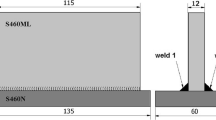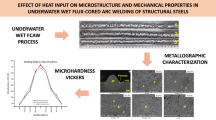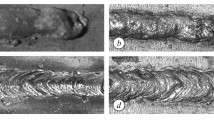Abstract
Underwater wet welding is a crucial repair and maintenance technology for nuclear plant. A boric acid environment raises a new challenge for the underwater welding maintenance of nuclear plant. This paper places emphasis on studying the influence of a boric acid environment in nuclear plant on the underwater welding process. Several groups of underwater wet welding experiments have been conducted in boric acid aqueous solution with different concentration (0-35000 ppm). The viscosity of the welding slag and the mechanical properties of welds, such as the hardness, strength, and elongation, have been studied. The results show that with increasing boric acid concentration, the viscosity of the slag decreases first and then increases at a lower temperature (less than 1441 °C). However, when the temperature is above 1480 °C, the differences between the viscosity measurements become less pronounced, and the viscosity tends to a constant value. The hardness and ductility of the joints can be enhanced significantly, and the maximum strength of the weld metal can be reached at 2300 ppm.









Similar content being viewed by others
References
H.T. Wang, G.Z. Wang, F.Z. Xuan, and S.T. Tu, Fracture Mechanism of a Dissimilar Metal Welded Joint in Nuclear Power Plant, Eng. Fail. Anal., 2013, 28, p 134–148
M.K. Samal, M. Seidenfuss, E. Roos, and K. Balani, Investigation of Failure Behavior of Ferritic-Austenitic Type of Dissimilar Steel Welded Joints, Eng. Fail. Anal., 2011, 18, p 999–1008
S.J. Yang and C.Y. Park, Estimates of Mechanical Properties and Residual Stress of Narrow Gap Weld for Leak-Before-Break Application to Nuclear Piping, J. Press. Vessels Trans. Asme., 2011, 133, p 021403–021409
N. Yurioka and Y. Horii, Recent Developments in Repair Welding Technologies in Japan, Sci. Techonl. Weld. Join., 2006, 11, p 255–264
X.F. Liang, H. Yi, Y.F. Zhang, and D. Li, Reliability and Safety Analysis of an Underwater Dry Maintenance Cabin, China Ocean Eng., 2010, 37, p 268–276
J.M. Verbeke, K.N. Leung, and J.D. Vujic, Development of a Sealed-Accelerator-Tube Neutron Generator, Appl. Radiat. Isotopes S., 2000, 53, p 801–809
C.A. Campbell, S. Fyfitch, and D.T. Martin, Boric Acid Corrosion of Carbon and Low Alloy Steels, Corrosion/94 Conference Papers, 1994
B. Cox and C. Wu, Transient Effects of Lithium Hydroxide and Boric Acid on Zircaloy Corrosion, J. Nucl. Mater., 1995, 224, p 168–178
M. Rowe and S. Liu, Recent Developments in Underwater Wet Welding, Weld. J., 2001, 6, p 387–396
I. Sohn and D.J. Min, A Review of the Relationship Between Viscosity and the Structure of Calcium-Silicate-Based Slags in Ironmaking, Steel Res. Int., 2012, 83, p 611–630
B.O. Mysen, D. Virgo, and C.M. Scarfe, Relations Between the Anionic Structure and Viscosity of Silicate Melts a Raman Spectroscopic Study, Am. Mineral., 1980, 65, p 690–710
J.B. Kim and I. Sohn, Influence of TiO2/SiO2 and MnO on the Viscosity and Structure in the TiO2-MnO-SiO2 Welding Flux System, J. Non-Cryst. Solids, 2013, 379, p 235–243
Y. Morizane, B. Ozturk, and R.J. Fruehan, Thermodynamics of TiOx in Blast Furnace-Type Slags, Metall. Mater. Trans., 1999, 30, p 29–43
G. Handfield and G.G. Charette, Viscosity and Structure of Industrial High TiO2 Slags, Can. Metall. Q., 1971, 3, p 235–243
V.R. Santos, M.J. Monteiro, and F.C. Rizzo, Development of an Oxyrutile Electorde for Wet Welding, Weld. J., 2012, 91, p 319–328
T.G. Gooch, Properties of Underwater Welds Part 1 Procedural Trials, Met. Constr., 1983, 3, p 164–167
X. Long, S.P. He, and J.F. Xu, Effects of Crystallization Behaviour of Mould Fluxes on Properties of Liquid Slag Film, J. Iron. Steel Res. Int., 2012, 19, p 39–45
S. Kim, Y. Kang, and C. Lee, Variation in Microstructures and Mechanical Properties in the Coarse-Grained Heat-Affected Zone of Low-Alloy Steel with Boron Content, Mater. Sci. Eng., 2013, 559, p 178–186
D. Anjana and K.D. Saikat, Strain Hardening Behavior and Cold Reducibility of Boron-Added Low-Carbon Steel, J. Mater. Eng. Perform., 2009, 18, p 109–110
Acknowledgment
We are grateful for the financial support to this study from the State Key Development Program for Basic Research of China (Grant No. 2013CB035502), the Shandong Provincial Science and Technology Development Plan (Grant No. 2014GGX103033), and Postdoctoral Science Foundation of China (Grant No. 2014M561343).
Author information
Authors and Affiliations
Corresponding author
Rights and permissions
About this article
Cite this article
Guo, N., Guo, W., Xu, C. et al. Effect of Boric Acid Concentration on Viscosity of Slag and Property of Weld Metal Obtained from Underwater Wet Welding. J. of Materi Eng and Perform 24, 2563–2568 (2015). https://doi.org/10.1007/s11665-015-1528-8
Received:
Revised:
Published:
Issue Date:
DOI: https://doi.org/10.1007/s11665-015-1528-8




